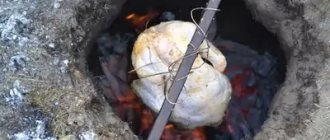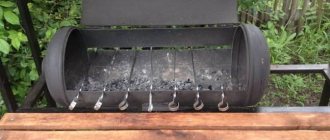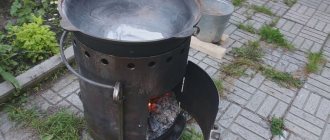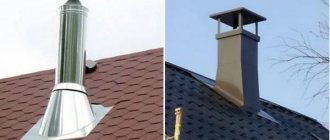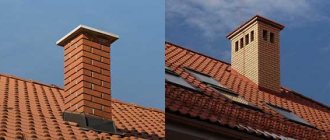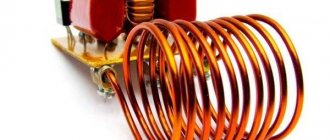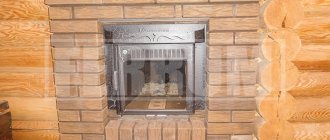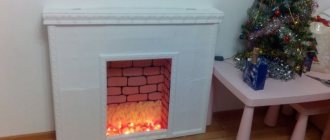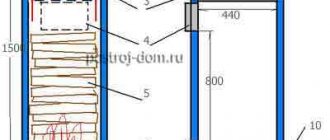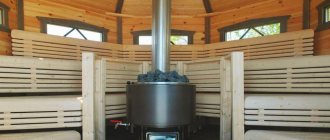Stove heating not only does not lose ground, but is also experiencing its rebirth. For this reason, issues of proper operation and maintenance of solid fuel units are no less pressing than they were several centuries ago. Owners of private households do not have any difficulties with how to light a stove and what kind of firewood is best to use. Problems begin when the draft disappears and smoke begins to flow into the room. And the whole reason is a smoke duct clogged with soot and soot. It is difficult to find a chimney sweep today, so you will have to carry out the maintenance of the chimney yourself. All you need for this is a chimney brush, which you can make yourself.
What causes clogged chimney pipes?
The advantages of stove heating, such as efficiency, autonomy and the ability to create a special, homely atmosphere, cannot be surpassed by any modern heating device. Thanks to this, stoves and fireplaces are still widely used in both rural areas and cities. However, the use of solid fuel has many disadvantages, one of which is the need to regularly clean the smoke ducts. But the frequency of their maintenance can be significantly reduced if you know where so much soot and soot comes from.
Deposits in the chimney can completely block the smoke exit channel
So, the main factors that contribute to chimney clogging are:
- burning of waste, which consists of high-carbon materials (all types of plastic, polyethylene, polystyrene foam, cardboard, etc.);
- use of wet firewood;
- violation of the operating mode of the heating device;
- heating with wood that contains a large amount of resin (pine, spruce, fir, etc.);
- ash is rarely removed from the working chambers of the furnace;
- violation of the fuel supply mode;
- ingress of third-party debris.
In addition, rapid contamination of the chimney can be caused by increased roughness of the walls of the flues and their incorrect configuration. For this reason, it is better to entrust the construction of the furnace to an experienced craftsman.
Dangers of soot accumulation
It is impossible not to notice problems with the chimney. Most often they will be indicated by the following signs:
- craving decreases;
- firewood does not light well when kindled;
- smoke is coming into the room;
- reduction in the thermal efficiency of the furnace.
All these factors indicate that the gas duct is so clogged that only a narrow hole remains for the combustion products to escape. Using a heating device in such conditions is prohibited, as this often leads to tragic consequences:
- a decrease in the cross-section of the smoke channels can provoke reverse draft, so the room may become smoked with carbon monoxide;
- soot flakes can ignite and fly out of the pipe, creating a fire hazard.
Accumulations of soot in the chimney can lead to a fire
If the soot is not removed in time, then the process of its deposition proceeds like an avalanche, since the combustion mode of the fuel is disrupted and, along with solid particles, unburned tarry secretions and moisture are deposited on the walls of the flues.
Why is it important to clean your chimney promptly?
The safety of those living in the house directly depends on the condition of the chimney. Unlike regular smoke, which has an odor, carbon monoxide is neither visible nor smelly. But its long-term effects on the human body can have lethal consequences. In addition, there are other reasons why cleaning pipes and chimneys becomes an important undertaking:
- The operation of the fireplace depends on the condition of the chimney. So, in order to ensure normal traction, the lumen area of the pipe must have dimensions that will be larger than a certain calculated value. The draft of a channel overgrown with soot gradually decreases. Having reached a minimum value, such a gap will not allow the oven to function normally.
- Due to chemical reactions and exposure to high temperatures, the walls of the chimney may begin to collapse over time. A large layer of soot will not allow you to see cracks and damage, taking all the necessary measures to eliminate them in time.
- Burning soot can cause sparks and flames, which can cause a fire.
- In addition to soot, the operation of the chimney can be interfered with by small debris and other foreign objects that have entered the chimney from the street.
Chimney cleaning equipment
Deposits can be removed from the chimney using chemical and mechanical methods. The first involves burning substances in a furnace, the combustion products of which soften soot deposits and promote their combustion and removal naturally. The second is to remove soot from the walls of the chimney using various scrapers, brushes, etc.
Chemicals for cleaning the chimney allow you to do without mechanical devices, but are quite expensive
Practice shows that mechanical cleaning is best done with a hard brush, like the one used for washing dishes with a narrow neck. A wide variety of materials are suitable for the manufacture of such a tool:
- steel rope;
- plastic bottles;
- pieces of steel wire;
- thick fishing line or plastic rods;
- springs;
- thick rubber;
- metal chain or strong rope;
- various weights and sinkers.
The choice of a particular material for making a brush for cleaning chimneys depends on how persistent soot deposits will have to be removed .
For regularly maintained chimneys made of steel or asbestos-cement pipes, a tool with soft bristles is suitable, while brick flues with many years of soot deposits can only be cleaned with a metal wire brush. It is best to have in your arsenal several devices of varying degrees of rigidity or make one combined tool.
How to make a stove maker's tool
Before you start making a device for removing soot deposits, you need to consider its design and dimensions. In this case, it is necessary to take into account:
- length of the chimney;
- flue diameter;
- quantity and persistence of deposits.
Based on the input data, conclusions are drawn about the length of the cable, the mass of the load, the size of the brush and its rigidity.
Design of a device for removing soot mechanically
The length of the rope or cable used to hold the brush is taken with a margin of 2–2.5 meters. This will allow you to hold the device more firmly in your hands, and, if necessary, make a loop around the chimney so as not to drop the tool into the chimney. Any weight can be used as a weight - from a specially cast lead blank to some heavy nut or a worn-out automobile part.
Making a plastic brush
A budget brush for removing soot from a chimney can easily be made from available materials. To make a plastic brush you will need:
- broom made of polypropylene rods;
- plumbing cable of the required length;
- metal pin with a diameter of 8 mm with an eye;
- nut with a diameter of 8 mm with an eye;
- washer with a diameter of at least 50 mm with a hole of 8 mm;
- 2 carbines;
- load 0.5–2 kg.
If you can't find a stud and lug nut, don't despair - a regular bolt will do. Loops for attaching the cable and load can be made of steel wire.
Materials needed to make a plastic chimney brush
The diameter of the brush made of plastic elements should be slightly larger than the cross-section of the smoke channel. This will provide increased pressure on the individual rods on the walls of the chimney and increase the cleaning speed.
The work is performed in the following order:
- Cut off or unscrew the stem from a synthetic broom; it will not be needed in the future. To make it more convenient to work, the remaining part is clamped in a vice.
- The bristles of the round broom are bent to the sides. To make the material more pliable, the brush is dipped in boiling water or heated with a hair dryer.
The rods of the plastic broom must be straightened - If there is no hole inside the holder, then drilling with a diameter of 8 mm should be made.
- On the side where the handle is attached, a steel pin with an eye is inserted into the hole.
The hairpin allows you to fix the bristles in the desired position - From the side of the rods, install a washer on the stud and press it with an eyelet nut.
The eyelet nut allows you not only to fix the rods of the brush, but also to attach a load and a cable to it - The rods are cut based on the diameter of the chimney.
Excessively long rods should be trimmed - A loop is made on one side of the cable, securing the metal edge with a knitting wire.
- Using carabiners, a cable is attached to one eye and a load to the other.
You can make a chimney brush yourself
In addition to a synthetic broom, plastic soda water containers are a good material for making a soft brush. To make a “lush” brush, you will need 5-6 such vessels and a sharp knife. It is necessary to cut off the bottom of all bottles and dissolve the walls into strips ranging from 3 to 10 mm wide. After this, the neck of all containers, except one, is cut off, leaving a hole slightly larger than the diameter of the neck. Assembly into a single structure is carried out by pushing the parts onto the remaining threaded part and securing them with a lid. After this, drilling is done for the pin and the brush is attached to the cable and weight in the manner described above.
To make the bristles from a plastic bottle more rigid, they are heated with a torch or a hair dryer. The same method can be used to give the brush the desired shape.
How to make a metal brush
To make a cleaning tool from metal, you can use pieces of steel wire (cable) or use a wire brush for an angle grinder. In the latter case, the angle grinder device is simply mounted on a cable with a load and secured with wire. If using a working tool for purposes other than its intended purpose is unacceptable to you, then you can make a metal brush with your own hands. For this you will need:
- a coil of steel wire Ø1–2 mm or a cable with a diameter of up to 5 mm;
- M8 pin or bolt 6–8 cm long;
- M8 lug nuts;
- washers with a diameter of at least 50 mm with an internal hole of Ø8 mm;
- pliers;
- hammer;
- chisel;
- spanners.
Steel wire is the basis of a homemade metal brush
The technology for making a metal brush is not complicated:
- The metal wire is cut into pieces whose diameter is at least 80% of the chimney cross-section. The easiest way to do this is with pliers. If a steel cable is used, then instead of wire cutters it is better to use a hammer and chisel, with which the material can be easily cut into pieces of the required length.
The length of individual rods of the device should be up to 80% of the chimney diameter - The rod is wrapped around the bolt in such a way as to obtain parts of the same length on both sides. The cable is installed on a pin, making an opening of the required size in the middle of each segment.
The metal bristles should be evenly distributed along the contour of the future brush. - The wire elements are wound along the entire length of the bolt, after which they are secured with a washer and nut - the metal brush for cleaning the chimney is ready.
For additional fixation, metal rods can be additionally secured by welding.
The simplicity of this method makes it extremely popular among home craftsmen. And at the same time, there is another very interesting tool that combines both a brush for removing soot and a weight. In addition to the tools and materials described above, for its manufacture you will need:
- steel pipe with a diameter of more than 50 mm;
- electric drill;
- high carbon steel core;
- a metal drill whose diameter corresponds to the cross-section of the wire or cable;
- sand-cement mortar.
To make a brush, exactly the same as in the previous case, prepare the required number of flexible elements. Then proceed like this:
- Through holes are made in the walls of the steel pipe. The density and uniformity of the bristles depends on the accuracy of this work and the step between drillings, so this stage should be treated as responsibly as possible.
- Wire elements are threaded into the holes, placing their edges symmetrically with respect to the pipe.
- A steel bar is installed in the center, to which the holding cable will later be attached.
- The inner surface of the pipe is filled with mortar, which will ensure fixation of the flexible elements and make the device quite heavy.
The tool can be used only after the cement-sand mixture has set and acquired the necessary strength.
Video: how to make a brush to remove soot from a chimney
What you need to know before lowering the tool down the chimney
The chimney should be cleaned not at the end of the heating season, but at the very beginning . This will allow you to have complete confidence that there is no bird's nest, cobwebs, leaves or other debris in the chimney. The best time for this is one of the warm and windless days in early autumn.
When cleaning a chimney, you should take care of the appropriate equipment and insurance.
Before you change into a chimney sweep suit and begin chimney maintenance, you must close all stove dampers and doors. Soot is tiny particles that can seep into any cracks and pollute the room and objects that are in it. If you have to service the chimney of a fireplace with an open firebox, then it is sealed using plastic film and tape.
The process of cleaning a chimney is not difficult. The brush is lowered repeatedly into the smoke channel, knocking deposits off the walls. To enhance the effect, alternate reciprocating movements with twisting the cable in different directions. The soot falls down. You can remove it through the inspection hatch using a dustpan, poker and broom.
There are situations when a device encounters an insurmountable obstacle halfway through its journey. This can be any voluminous object - some kind of rag, a bird's nest, or a piece of brick that has fallen out of the masonry. In this case, the brush is unfastened and the resulting jam is knocked out with just a weight, in the expectation that the cork will fall into the stove. After this, the brush is returned to its place and cleaning activities are resumed.
Regular soot removal will be required even where the latest, high-tech solid fuel equipment is used. The brush, which you can make with your own hands, will cope with even the most stubborn deposits with dignity. It’s just important not to put off cleaning the chimney for too long - not only the thermal efficiency and economics of the stove depend on it, but also the safety of your family.
Prices for professional chimney sweep services
If you use your fireplace more than four times a week, you will need to have your chimney cleaned on a regular basis. This is one of the most important factors determining the cost of chimney sweep services, since the more often your fireplace or stove is used, the more clogs will form on the walls of the chimney.
In order for the cleaning to be as effective as possible, it is advisable to clean from both the house and the roof.
If you have been using your fireplace for many years and have never had it cleaned, the cost of a professional may be much more expensive than any subsequent cleaning, as long-term clogs are very difficult to remove.
Approximate prices for chimney sweep services
Prices may vary depending on your region. The table below shows prices in Moscow and the Moscow region.
| Chimney sweep visit | 1000 rubles |
| Initial chimney diagnostics | 6000 rubles (diagnostics) + 7000 rubles (payment for departure) |
| Mechanical cleaning | 600 - 1000 rubles - per meter of vertical section; 800 - 1000 rubles - per meter of horizontal section. Fireplace cleaning - from 1000 rubles; Oven cleaning - from 2000 rubles. Removing additional blockages in the form of nests or foreign objects can cost up to 8,000 rubles, depending on the degree of contamination. |
Dry cleaning is not carried out by specialists and is strictly not recommended for independent use. For an additional fee, a specialist can advise you on how to clean a chimney pipe in a private home yourself.
Always remember that even with proper care, you will not be able to avoid dirtying your chimney, it is just a matter of time. Clean every few months to avoid carbon monoxide poisoning and indoor odors. Despite the apparent effectiveness of home remedies and the use of chemicals, nothing can replace high-quality mechanical cleaning.
